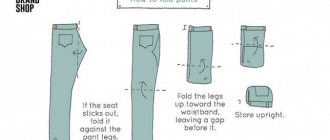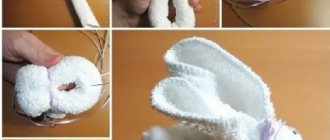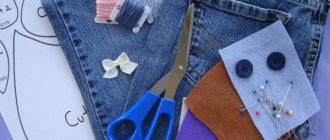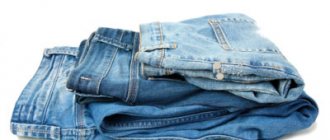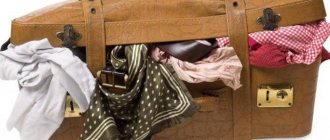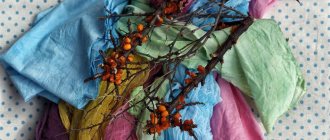What's the best way to store pants?
The ideal option for storing trousers is, of course, on hangers, and in the following way:
The trouser legs are clamped with two horizontal strips (for classic trousers) or clothespins (for trousers made of thick fabric) on both sides at the very bottom. It turns out that the trousers hang full length downwards with their pockets, which requires a sufficient height of the closet. The good thing about this method is that it virtually eliminates the risk of the trouser fold shifting.
The classic “change-over” option is also not bad, but long-term storage may leave creases in the knee area. Hangers with a horizontal bar, wide and upholstered with soft foam, can minimize the appearance of creases. The trousers are thrown over the soft shelf of the hanger and wait for the owner without loss of appearance:
How to make an insert in the middle of trousers
This option is difficult, but very interesting and unusual. You can cut trousers in different ways:
- straight cut;
- oblique cut.
Consider a straight cut. We cut off the trousers exactly in the center of the knees, measuring in advance and drawing a straight line on the leg. We make the insert from identical fabric or similar in color and thread weave. Cut out a strip of the desired height and length and sew it on.
To style it, the insert can be cut into several pieces and re-sewn. Or, without cutting, make folds that are stitched with a double seam, imitating a cut.
You can lengthen your jeans using unusual details - lacing or chains. Cut the trousers in the middle, higher or closer to the bottom. The cut edges can be hemmed, overlocked, or fluffed up as a fringe.
Then insert eyelets (small diameter metal rings) onto both parts of the trouser leg in parallel(!), at an equal distance from each other.
You can thread a cord through the eyelets, connecting both halves, without tightening it too much. You can also attach metal or plastic chains of the same length to the eyelets using rings.
Having cut the trouser legs diagonally, we very carefully cut out the fabric for insertion. It also needs to be cut obliquely so that the grain goes from bottom to top or vice versa. A lace insert will look very original.
The trouser sections can be processed or left as is. Place the lace insert on top and sweep it by hand, check for movement, and measure. Then stitch.
Processing pockets and darts
Sew darts along the marked lines on the front and back halves of the trousers. First, iron the dart allowances to the edge, then iron them to the middle cuts, ironing the slack at the ends of the darts.
On the main parts, process pockets: a pocket with a cutting side, a pocket with a frame, an invoice.
Overcast all sections of the main parts, except for the waist line.
Secure the waistline in each half of the trousers from stretching by making a fine stitch or gluing it with a strip of non-woven fabric.
Prepare the bottom of the trousers for sewing the instep and side seams. If you have a regular hem at the bottom, you can immediately glue the inside of the hem and its seam allowance, and if you have a hem with a cuff, you can glue it depending on the type of cuff.
Types of materials
Accessories for trousers are made mainly from 3 materials: wood, metal and plastic.
Wooden models are the most durable, but also the most expensive. From the outside they look very stylish and can withstand the weight of thick fabrics well.
Metal models are also quite durable, and in addition have an attractive mirror shine.
Plastic accessories have the most affordable prices and short service life. Designed for storing lightweight items (cotton, linen, etc.).
How to properly stack folded items
Knowing how to fold your pants correctly is not enough to simplify your search and keep things organized. If the jeans are not lying correctly, over time the interior of the closet will return to chaos, and the jeans will again become wrinkled, and sometimes forgotten.
To avoid a mess, jeans should be folded in the closet, following the rules:
- pants must be alternated with the side of the fold so that the “slide” does not fall on its side;
- the stacks should be located next to each other, without blocking access to the necessary things;
- laying jeans so that only one fold is visible to the eye while pulling out the pants, this will avoid grabbing an unnecessary pair:
- arrange products by color;
- thick pants down, thin pants on top.
All clothing placed in the closet must be clean. The folds of the jeans must be straightened and the contents of the pockets removed.
Video
Reading time:
6 minutes
It is not uncommon to encounter a situation where, when opening the doors of the dressing room, piles of things fall out, creating chaos. And how great is the temptation to get the necessary pair of trousers, put them on without ironing and wasted time searching. Often, a mess in a closet happens due to the inability to properly manage the internal space. Knowing how to fold jeans and any other item saves space and makes it possible to keep your clothes looking presentable.
How to put it in a suitcase or chest of drawers without getting wrinkled
If there is a trip ahead, they try to take only the necessary things on the road. There are two recommended ways to fold trousers:
- The pants are laid out on a flat surface. Smooth the fabric with your hands. Fold in half, placing one pant leg on top of the other. Make sure that all seams match. If there are arrows, then fold along their fold line. Then the product is folded vertically in half. The lower edge of the legs is raised to the waist. The clothes are picked up, shaken and folded in half again.
- The trousers are laid out on the surface and the folds are smoothed out. Bend the product in half lengthwise. After this, with careful movements they begin to twist the product from the bottom to the waist, forming a tube.
Tips to help you pack clothes compactly in your suitcase:
- remove the belt, empty the pockets;
- Clothes are ironed before being put into a suitcase, laid out on a flat surface;
- as soon as the pants have cooled down, start folding them;
- It is better to place trousers made of delicate fabric on top of all the clothes folded in the suitcase;
- jeans and pants made of thick material are placed on the bottom;
- It is recommended to lay a polyethylene layer between clothes.
How to fold dresses and sundresses
A long sundress is also unrolled on a flat surface before laying. Next, it is smoothed out well so that there are no creases or wrinkles left and is folded down along the waistline. Then the right and left hems are folded towards the center (you can overlap if the skirt is too full) to form a rectangle. Starting from the top (from the waist line), the roll is rolled.
Read also: What color is graphite metallic?
The hem is folded 10-15 cm and a sundress rolled into a tube is placed in the resulting pocket.
Before laying, you can carefully straighten the fabric again. Any dress is a combination of triangles and rectangles, and the same principle should be used when packing them into a suitcase. Even if the hem of a skirt or dress is very wide, these triangles are folded with both parts inside the rectangle.
Read also: Colors of HYUNDAIKIA Koreana
General rules
Proper folding of clothes has many advantages:
- no need to waste time on ironing;
- the free space on the cabinet shelves will increase significantly;
- the aesthetic appearance created by neatly arranged things;
- you will be able to quickly find the thing you need.
Before folding clothes, you need to remember a few simple rules:
- empty pockets and straighten them so that they do not stick out;
- remove the belt;
- if there is a fold, then it is better to straighten it;
- the seams when bending should be located at the edges so that folds do not appear;
- the pants are folded in half towards the waist so that the edge does not touch the waist line;
- if necessary, the product is bent again;
- For even more compact storage, the rest of the trouser legs are rolled into a tube.
Mistakes that may cause wrinkles to reappear
Sometimes jeans owners are surprised. It seemed like the jeans were handled properly, but wrinkles still appeared. This happens in several cases:
- Trousers that remain damp or have not cooled down after ironing are sent to the closet.
- The belt was still on the jeans.
- The trouser legs are laid on top of each other carelessly, the folds on them appear not at the seam, but in other places.
- Keys or other items remain in pockets.
Any of these reasons can cause the legs to become skewed, resulting in creases.
How not to fold jeans
You cannot follow some rules and ignore others. You should pay attention to the prohibited manipulations of folding and storing pants in order to avoid unnecessary creases and the appearance of contrasting stripes:
- do not throw jeans into the closet without folding them;
- avoid bending near seams;
- fold into a rectangle, no diagonals;
- Do not put wet items in the closet.
It is not difficult to follow the rules so that further use of clothing is pleasant. Having opened a closet, you always want to quickly find what you need and put it on, rather than rummaging through a pile of wrinkled “rags.” It's worth spending 2 minutes at the beginning to enjoy a free 15 minutes at the end.
Useful tips
Knowing how to fold jeans compactly is not enough; you need to properly organize the space in your closet. First you need to go through all the things and remove those that are rarely used. Folded piles should be sorted by color and seasonality, access to them should be quick, and all details should remain visible.
When putting jeans away for storage, you need to follow clear rules to avoid such troubles as creases or contrasting stripes. It is not recommended to throw things into the closet haphazardly without folding them. Also, you should not fold damp, not completely dried wardrobe items, otherwise they will smell unpleasant. It is difficult to get rid of this smell, and it also attracts pests.
When folding trousers or jeans, you need to avoid folds near the seams, they cause contrasting stripes. It is better to fold the item compactly into a rectangle, so it is less deformed. Do not fold diagonally, otherwise creases may form that will be impossible to get rid of.
How to fold sweatpants
It’s very easy to compactly fold your workout things so they don’t unfold in your bag. Pants made of thick knitted fabrics can be folded in the following way:
- Fold the pants in half, pant leg to pant leg. Fold the crotch seam towards itself.
Fold the jeans, straightening the seams and folds - Next, fold the top edge, not reaching the knee. Do the same with the bottom of the pants. Fold them from below again, reaching the waist.
Fold the top and bottom edges of the pants to the middle - Open the hole in the belt and tuck the free edge of the pants into it.
Tuck the legs into the waistband to create a small rectangle.
Sweatpants folded in this way can easily fit into any bag and can be conveniently stored on a shelf. The method is suitable not only for sports pants, but also for casual trousers and thin jeans.
Folding things using the Konmari method
When folding using the KonMari method, you need to take stock of your values and figure out which jeans should be recycled and which ones should be kept. In almost every home there are pants that are not used for going outside, but throwing them away is not an option. Often, this is just a psychological attachment to objects with which there has been contact for a long time. Don't keep jeans that evoke memories. A clean closet is a byproduct of decluttering.
Video instruction:
After analyzing and making the right decisions about the need for this or that thing, you should move on to the method of folding the pants itself:
- the method is based on rolling clothes, like a Japanese roll;
- trousers are folded in half (trouser leg to trouser leg);
- the resulting “triangle” formed from the back seam is folded over to create a long rectangle;
- the edge of the trouser leg is folded towards the belt with a slight indentation from it;
- the resulting rectangle is visually divided into three parts and bent to form a parallelepiped;
- Store jeans vertically so they take up little space.
Shoulder eversion method
When using it, you can preserve the quality of the item and its shape.
- Grab the garment by the collar and turn the shoulder inside out.
- Do not twist the other shoulder. It must be inserted right side into the inside out, so that the seams of the shoulders on both sides fit into each other and coincide. But the jacket must be turned inside out.
- Then you need to align the sides of the product along its side seams, slightly straightening it and pulling it towards the bottom. The main part of the product must be folded like a rectangle, also as indicated in the previous method.
- After aligning the sides at the seams, the jacket needs to be folded in half. You will receive a square.
Your jacket is now ready to travel.
Method 1: Using a clothes hanger
- Take a regular clothes hanger. A standard clothes hanger has the shape of a triangle formed by two side arms running diagonally from the hook and a horizontal bar connecting the other ends of the side arms. This method is great for any type of trousers. But it also has a drawback: the likelihood that the trousers will slip off is quite high.
- Consider adding a strip of corduroy, moleskine, or a layer of hot glue to the bottom rail. This will help increase the adhesion between the contacting surfaces of the hanger and the pants. Whatever you choose as the extra layer for the bottom rail, glue it to the top of that hanger piece, since that's what will be in contact with the pants. Or cover the entire bottom of the hanger with this material.
How to fold trousers correctly?
If your goal is to fold your trousers so that you can take them out, iron them and put them on in the near future, everything is simple here:
Option 1: Fold the trousers in half first, and then in half again to form a rectangle.
Option 2: Pants made of thick fabric; jeans are folded in half along the legs and then rolled into a tube. An excellent option for transportation - this way the trousers will take up little space.
However, all of the above methods are not so good if carefully ironed classic men's trousers must be packed in a suitcase and worn immediately afterwards. In this case, you should act very carefully and adhere to the axioms of baggage packing. Yes, yes, it's a whole science
